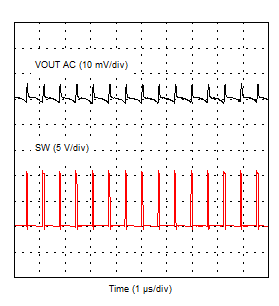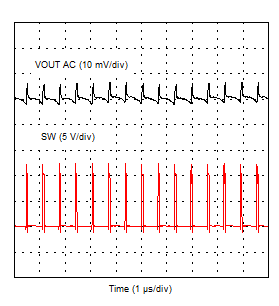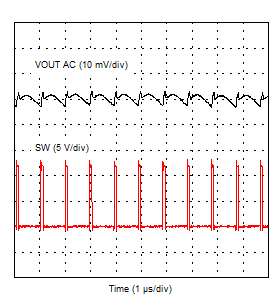SLVUBQ1A August 2020 – May 2021 TPS543620
- Trademarks
- 1Introduction
- 2Configurations and Modifications
-
3Test Setup and Results
- 3.1 Input/Output Connections
- 3.2 Efficiency
- 3.3 Output Voltage Regulation
- 3.4 Load Transient and Loop Response
- 3.5 Output Voltage Ripple
- 3.6 Input Voltage Ripple
- 3.7 Synchronizing to a Clock
- 3.8 Start-up and Shutdown with EN
- 3.9 Start-up and Shutdown with VIN
- 3.10 Start-up Into Pre-Bias
- 3.11 Hiccup Current Limit
- 3.12 Overvoltage Protection
- 3.13 Thermal Performance
- 4Board Layout
- 5Schematic and Bill of Materials
- 6Revision History
3.5 Output Voltage Ripple
Figure 3-16 through Figure 3-19 show the TPS543620EVM output voltage ripple. The load currents are no load and 6 A. VIN = 12 V. The VOUT voltage is measured using TP10 for U1 and TP29 for U2.
 Figure 3-16 U1 Output
Ripple – No Load
Figure 3-16 U1 Output
Ripple – No Load Figure 3-18 U2 Output Ripple – No Load
Figure 3-18 U2 Output Ripple – No Load Figure 3-17 U1 Output
Ripple – 6-A Load
Figure 3-17 U1 Output
Ripple – 6-A Load Figure 3-19 U2 Output Ripple – 6-A Load
Figure 3-19 U2 Output Ripple – 6-A Load